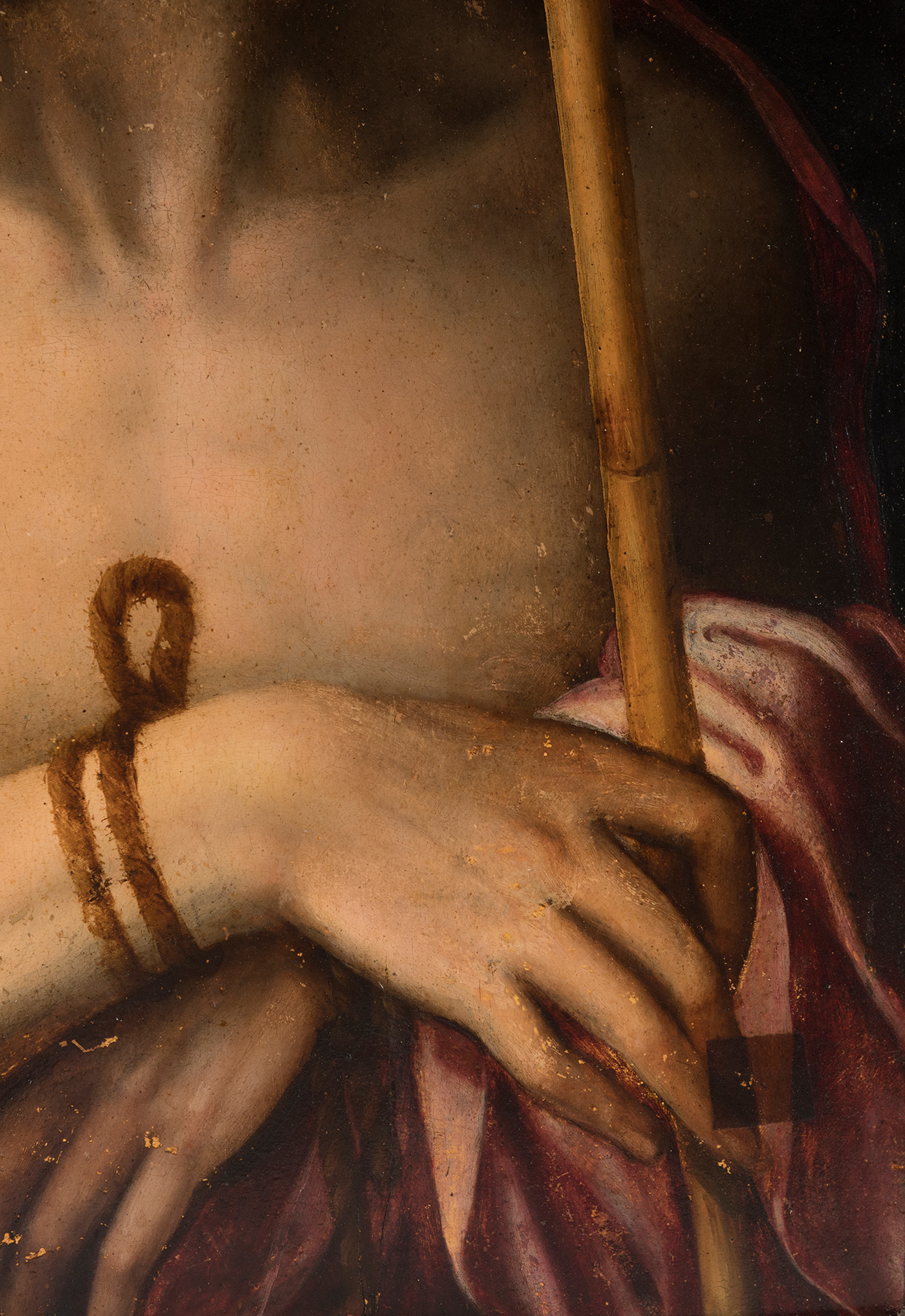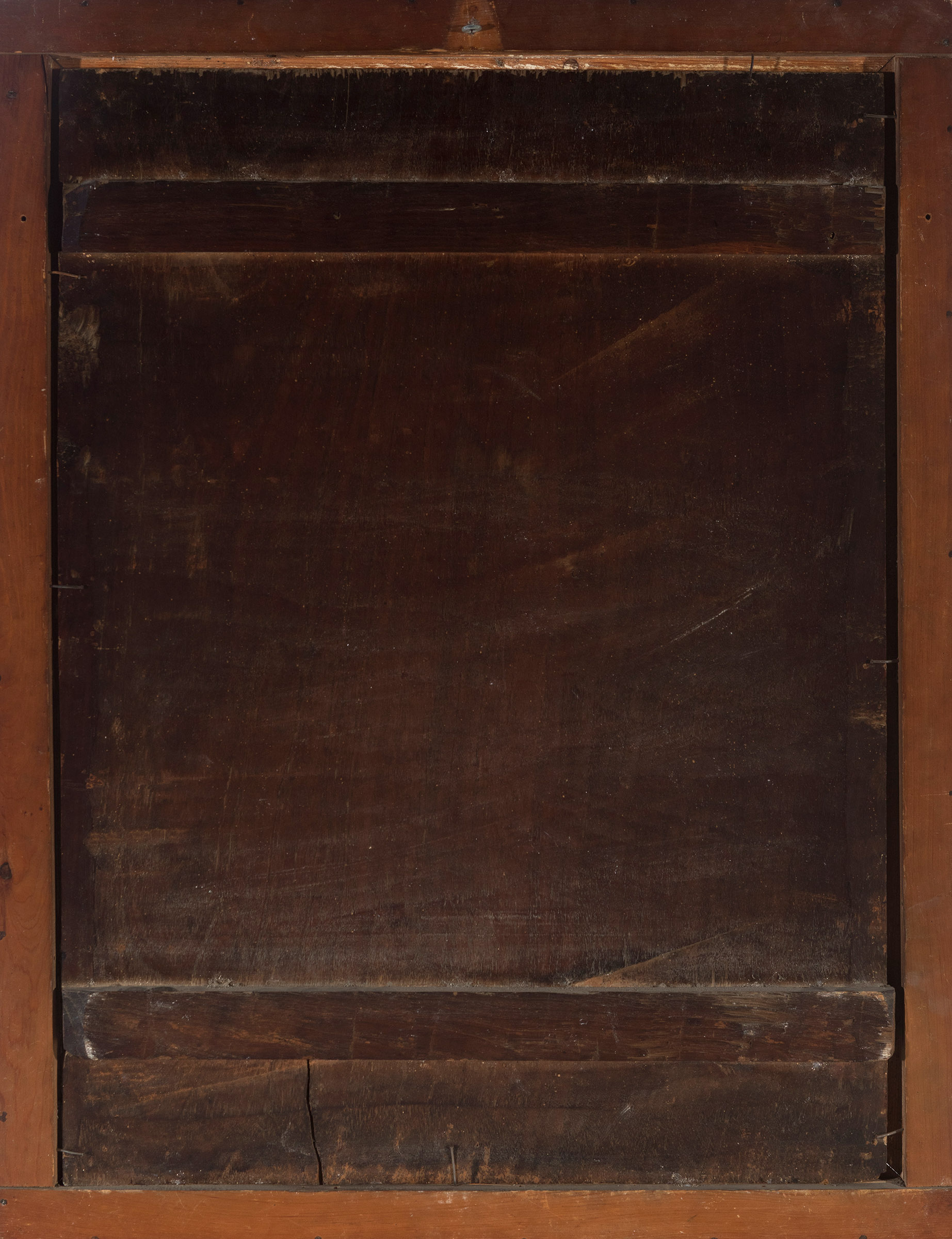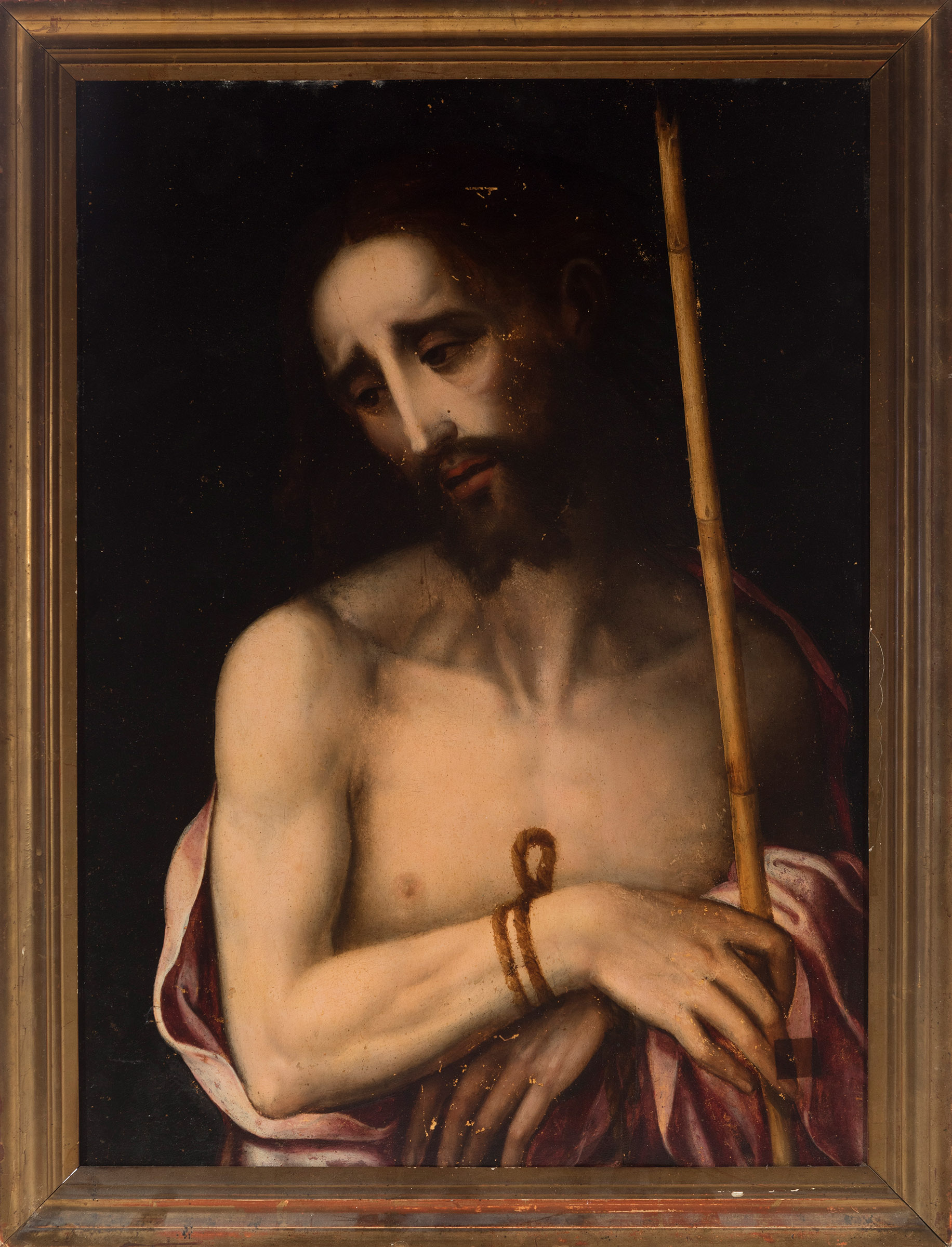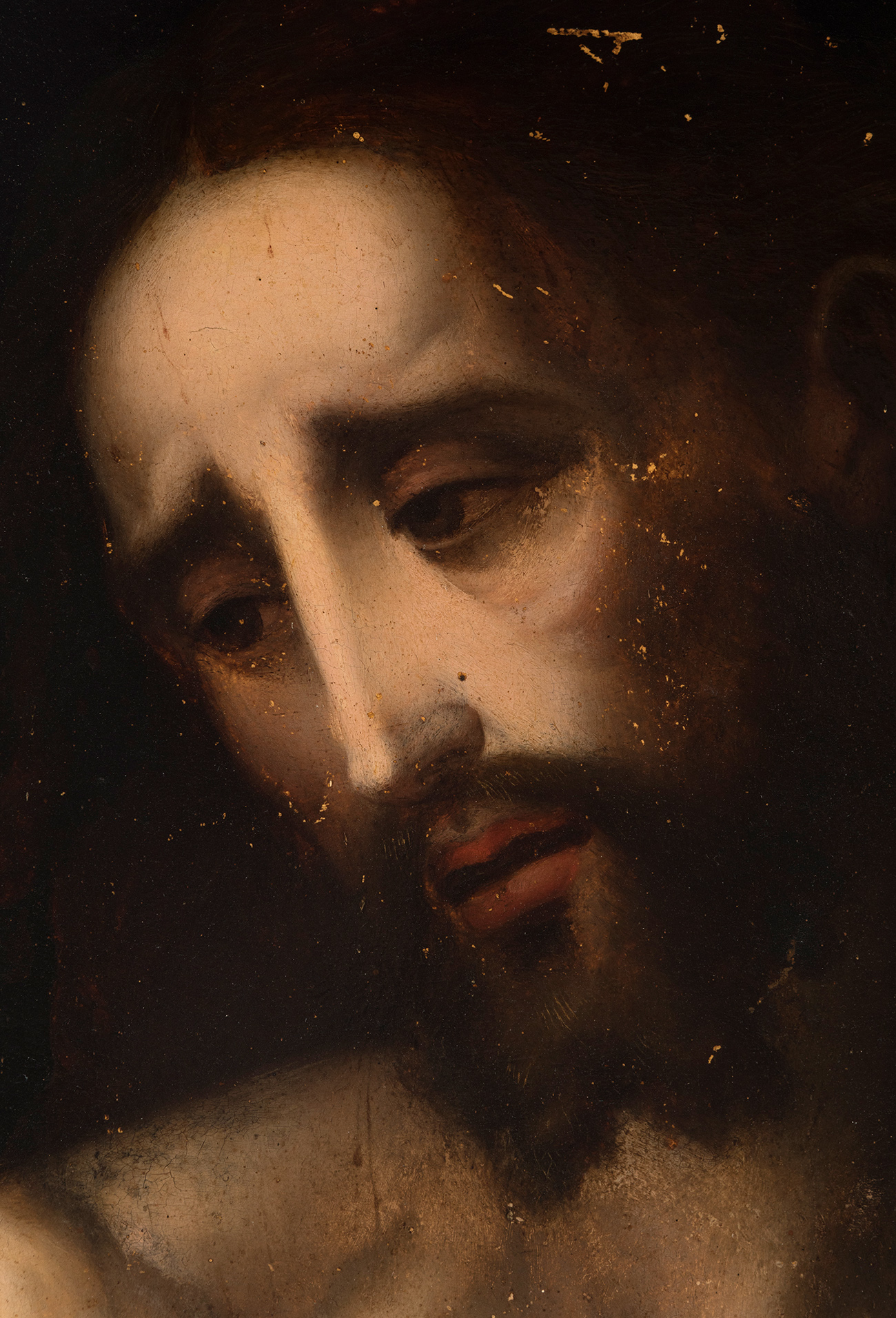8
Workshop of LUIS DE MORALES (Badajoz, 1509 - Alcántara, 1586)."Ecce Homo", ca.1570.Oil on panel.
"Ecce Homo", ca.1570.
Oil on panel.
Andalusian frame from the 18th century.
It shows damage to the polychromy, losses and restorations.
Provenance: Private Collection Barcelona s.XX; Lacalle de Castro Collection, pps. s.XX.
Measurements: 75 x 57 cm; 66 x 48 cm (frame).
This devotional panel is a direct descendant of the paintings of the same subject by Luis de Morales. Due to the proximity in theme and treatment, it is considered an artist from the workshop of the Flemish-Andalusian master. With his meticulous execution and tenebrist light, he conveys the Passionary moment with his masterly handling of chiaroscuro, having learned from Morales (see the Ecce Homos in the Museo del Prado and the Staatliche Kunstsammlunguen Museum in Dresden). The figure is cut half-length against a black background, emphasising his gaunt anatomy and gaunt skin, his bowed head and sorrowful eyes. With one long-fingered hand he holds the cane like a sceptre. He communicates an intense, emotionally charged pathos, conveying a mystical experience. The theme of the Passion of Christ is one of the most significant aspects of Luis de Morales's iconography. The Ecce Homo and its variant as the Man of Sorrows, in Morales's works, were very popular in his day, and several versions of these themes were produced.
The Ecce Homo theme precedes the Crucifixion episode. The words "Ecce Homo" are those pronounced by Pilate when presenting Christ to the crowd; their translation is "behold the man", a phrase by which he mocks Jesus and implies that Christ's power was not such in comparison with that of the leaders who were judging him.
Luis de Morales is considered one of the Spanish painters of the second half of the 16th century. His training poses serious problems, although Palomino describes him as a pupil of the Flemish painter who lived in Seville between 1537 and 1563. His use of colouring and sfumato is related to the Lombard tradition of Bernardino Luini and Cristoforo Solario, whom he probably met not on a trip to Italy but possibly to Valencia, in order to keep abreast of the innovations of the Leonardo painters Fernando Yáñez and Fernando de Llanos and the Raphaelesque painters Vicente and Juan Masip. However, the most personal aspect of his painting lies in the tormented, almost hysterical atmosphere in which his figures breathe, more focused on an intense inner life than on action, full of melancholy and ascetic renunciation and characteristic of the climate of tense religiosity imposed in 16th-century Spain by the reform movements, from the less orthodox Erasmianism and Alumbradism to the more genuine mysticism and Trentism. Morales, called the Divine by his first biographer, Antonio Palomino, because he painted only religious subjects with great delicacy and subtlety, reached his peak from 1550 to 1570, when he painted numerous altarpieces, He painted numerous altarpieces, triptychs and isolated canvases that were widely distributed because they satisfied the popular religiosity of the time, although some of his canvases contain quotations and information of literary erudition, the result of his contact with enlightened clients, primarily the bishops of the diocese of Badajoz, in whose service he worked. On the other hand, his presence in the monastery of El Escorial, called by Philip II, is not documented, although it seems that the latter acquired some of his works to give them as gifts. The enormous production and the continuous demand for his most frequent and popular iconographic themes obliged him to maintain a large workshop in which his two sons, Cristóbal and Jerónimo, collaborated; a workshop responsible for many copies that circulate and are still considered to be Morales's autograph works.
"Ecce Homo", ca.1570.
Oil on panel.
Andalusian frame from the 18th century.
It shows damage to the polychromy, losses and restorations.
Provenance: Private Collection Barcelona s.XX; Lacalle de Castro Collection, pps. s.XX.
Measurements: 75 x 57 cm; 66 x 48 cm (frame).
This devotional panel is a direct descendant of the paintings of the same subject by Luis de Morales. Due to the proximity in theme and treatment, it is considered an artist from the workshop of the Flemish-Andalusian master. With his meticulous execution and tenebrist light, he conveys the Passionary moment with his masterly handling of chiaroscuro, having learned from Morales (see the Ecce Homos in the Museo del Prado and the Staatliche Kunstsammlunguen Museum in Dresden). The figure is cut half-length against a black background, emphasising his gaunt anatomy and gaunt skin, his bowed head and sorrowful eyes. With one long-fingered hand he holds the cane like a sceptre. He communicates an intense, emotionally charged pathos, conveying a mystical experience. The theme of the Passion of Christ is one of the most significant aspects of Luis de Morales's iconography. The Ecce Homo and its variant as the Man of Sorrows, in Morales's works, were very popular in his day, and several versions of these themes were produced.
The Ecce Homo theme precedes the Crucifixion episode. The words "Ecce Homo" are those pronounced by Pilate when presenting Christ to the crowd; their translation is "behold the man", a phrase by which he mocks Jesus and implies that Christ's power was not such in comparison with that of the leaders who were judging him.
Luis de Morales is considered one of the Spanish painters of the second half of the 16th century. His training poses serious problems, although Palomino describes him as a pupil of the Flemish painter who lived in Seville between 1537 and 1563. His use of colouring and sfumato is related to the Lombard tradition of Bernardino Luini and Cristoforo Solario, whom he probably met not on a trip to Italy but possibly to Valencia, in order to keep abreast of the innovations of the Leonardo painters Fernando Yáñez and Fernando de Llanos and the Raphaelesque painters Vicente and Juan Masip. However, the most personal aspect of his painting lies in the tormented, almost hysterical atmosphere in which his figures breathe, more focused on an intense inner life than on action, full of melancholy and ascetic renunciation and characteristic of the climate of tense religiosity imposed in 16th-century Spain by the reform movements, from the less orthodox Erasmianism and Alumbradism to the more genuine mysticism and Trentism. Morales, called the Divine by his first biographer, Antonio Palomino, because he painted only religious subjects with great delicacy and subtlety, reached his peak from 1550 to 1570, when he painted numerous altarpieces, He painted numerous altarpieces, triptychs and isolated canvases that were widely distributed because they satisfied the popular religiosity of the time, although some of his canvases contain quotations and information of literary erudition, the result of his contact with enlightened clients, primarily the bishops of the diocese of Badajoz, in whose service he worked. On the other hand, his presence in the monastery of El Escorial, called by Philip II, is not documented, although it seems that the latter acquired some of his works to give them as gifts. The enormous production and the continuous demand for his most frequent and popular iconographic themes obliged him to maintain a large workshop in which his two sons, Cristóbal and Jerónimo, collaborated; a workshop responsible for many copies that circulate and are still considered to be Morales's autograph works.
9th November - Old Masters
Sale Date(s)
Venue Address
General delivery information available from the auctioneer
Setdart offers Worldwide shipping
PICK UP IN ROOM: You can come and pick up your lots in our offices (Barcelona, Madrid or Valencia). At the moment of the withdrawal, you will be able to accept the current conditions of the lot by means of a document that you will sign.
YOU CAN SEND ANOTHER PERSON TO PICK UP: This person must present a signed authorization that you can find in our web page by accessing from BUY AT SETDART- LOGISTICS-DOWNLOAD AUTHORIZATION DOCUMENT. You can also send an e-mail with the requested data in AUTHORIZATION DOCUMENT to admin@setdart.com
Important Information
25% buyer´s premium
OR
21% buyer´s premium at www.setdart.com
Terms & Conditions
The maximum period to pay the lots is 7 working days. You can pay either via bank transfer or with credit card through our platform www.setdart.com (we only accept VISA or Mastercard).
BUYER´S PREMIUM: 22% Hammer price + 21% VAT from the buyer´s premium
If your piece has more than 100 years, our Ministry of Culture requires an export certificate in order for the piece to leave the country. Note that if the piece goes inside the EU, there is no cost for the export certificate. If the piece goes outside the EU, there is a cost for the export certificate. You can find more information in our Ministry of Culture website: https://www.culturaydeporte.gob.es/en/cultura/patrimonio/exportacionimportacion/exportacion/tasas.html
INQUIRIES: admin@setdart.com
Setdart guides you through the entire process, from the time of award to the day you receive your lot. Our logistics team will be happy to manage your transport, and will advise you on the best shipping method with professionals from the sector used to handling works of art and jewelry.
WE OFFER WORLDWIDE DOOR TO DOOR SHIPPING
PICK UP IN ROOM: You can come and pick up your lots in our offices. At the moment of the withdrawal, you will be able to accept the current conditions of the lot by means of a document that you will sign.
YOU CAN SEND ANOTHER PERSON TO PICK UP: This person must present a signed authorization that you can find in our web page by accessing from BUY AT SETDART-LOGISTICS-DOWNLOAD AUTHORIZATION DOCUMENT. You can also send an e-mail with the requested data in AUTHORIZATION DOCUMENT to admin@setdart.com
SETDART IS NOT RESPONSIBLE FOR THE STATE OF THE PARTS ONCE THEY LEAVE OUR FACILITIES. MRW SHIPMENTS: Once the payment is made, your lot will be packed for shipment, the logistics department will send you an e-mail notifying you of the day it leaves our warehouse, changes of address cannot be made after receiving this e-mail.
INSURANCE INCIDENTS: Coverage for the value of the auction up to 3000 ? per shipment, if the value of the auction is higher, Setdart will send you a quote including the additional insurance. The insurance company WILL NOT BE RESPONSIBLE FOR THE SHIPMENT THAT EXCEEDS THAT AMOUNT AND IS NOT FULLY INSURED. MRW INCIDENTS: Maximum notification 48 hours after receipt, after which the insurance company WILL NOT BE RESPONSIBLE AND NO CLAIMS WILL BE ACCEPTED.
E-MAIL LOGISTICS: logistica@setdart.com
PICK UP YOUR MESSAGES: You can send your own messaging, prior notice via e-mail that your shipment is ready, please note 3 or 4 days in advance. This type of shipment is packaged so Setdart will provide you with a quote.
EXPENSES FOR STORAGE: We inform you that if the purchased lot is not picked up within a month, you will be charged 30€ per week per lot. Setdart Online S.L., owner of the web site "setdart.com", "setdart.net" and "setdart.org", acts as a company of Spanish nationality inscribed in the Volume 36955, sheet 182, page B-293056 of the Mercantile Registry, with registered office at Calle Aragó


















